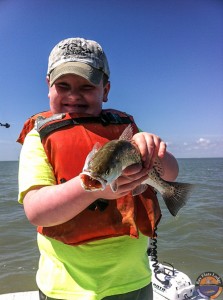We’ve talked a lot in recent editions of Guide Lines about how much the wind can blow at this time of the year along the Texas Gulf coast, and the past few weeks have been no exception. When you wake up in the morning it can be anyone’s guess as to what might happen by day’s end with regards to the wind, and there have been days when I thought it would never stop blowing. One morning it might be absolutely beautiful with a slight breeze coming out of the northeast at about 3-5mph. So you setup wade sessions along a clean shoreline only to be blown off the water in a couple hours by an ever-increasing southeast wind that muddies the water as fast as you can blink an eye. The next day you hope you have planned accordingly by setting out for a favorite shoreline that’s protected from the strong southeast wind. You reach your destination right as the sun begins to shine and the wind is already howling between 15-20mph. After a couple hours of daylight, the sun warms the air enough to increase wind gusts to 25 and 30 mph. Even with good protection you have to fish fairly tight to the bank. That afternoon you head home thinking things can’t get much worse, and that the wind should subside during the night. You awake the next morning to a 20 mph wind out of the north due to the onslaught of the latest brief frontal passage, and suddenly all the plans you made last night for this morning’s trip now have to be reconsidered and altered. I know I’m not telling a lot of you anything new here, as I realize we’ve all probably experienced this at some point in our fishing careers. The wind can be a very frustrating thing when it wants to be.
Working around the squirrely winds that have been associated with the ending of March and the start of April has proven to be quite challenging at times, to say the least. But I have found success atop shell-spotted shorelines and hard, sandy bottoms whenever I’ve been able to access such areas. I’ve waded a lot of miles over the course of the past few weeks, and have come up empty handed whenever in the absence of baitfish activity of some sorts. If I find a jumping mullet (or two), I immediately stop walking and fish the entire area thoroughly. In instances like this I fan out casts at almost every angle before taking any advancing steps with my feet. When I do finally move, I may only take 10-15 steps before stopping and then fan-casting again. Incorporating this strategy, along with zig-zagging whenever moving along a shoreline, is one of my favorite methods of scouring the area in search of big springtime trout and red fish.
To-date, there has not been a lot of shrimp in the bays, so I have maintained the use of mullet-imitating baits whenever possible. There’s a special place in my heart for the top water action that generally tends to turn on around this time each season, so I do spend a certain amount of time each outing throwing some of my favorite surface plugs. And although the bite on top hasn’t quite started it’s spring pattern yet, I still feel like I owe it to myself to at least try it for a little while each trip (just in case!)
I’ve recognized recent successes while using dark-colored, bottom-hugging, plastic mullet imitations like the Texas Tackle Factory’s Killer Flats Minnow in Morning Glory, Texas Roach, and Plum Chartreuse colors. The fish love them and they’ve proven to be more than effective for me in the presence of low-light conditions and somewhat muddy water. I like attaching these baits to a 1/16-ounce laser-lock jighead if I can get away with it. I prefer the lighter jighead because I like to barely let the bait touch the bottom when I’m working my retrieve. The lighter weight also performs a lot better for me in the event I happen to be working the bait over shell or grass. I also sometimes like to return the bait to me using a slow, steady retrieve, and using a lighter weight allows me to work the bait back to me at just about any depth I prefer, allowing me to easily cover the entire water column if I prefer.
The water temperature should soon rise to the point to where we can begin wading in just our fishing pants and not have to lurch around in those heavy chest waders we’ve been wearing for the past several months. However, it’s extremely important to realize that we shouldn’t get too comfortable with the nice springtime weather. It’s important to still take caution when spending the entire day out in the sun. I know it feels good to not have to bother with layers of clothing in order to get in the water, but be careful and protect yourself. Coat exposed skin areas with ample amounts of UV-protective sunscreen, and cover your arms and legs with long-sleeved shirts and long pants. Oh…and…uh…don’t forget the stingray boots either!
Remember to practice CPR, “Catch, Photo, and Release”, whenever possible on trophy Trout and Reds…Guide Chris Martin, Port O’Connor/Seadrift region.www.BayFlatsLodge.com…1-888-677-4868

